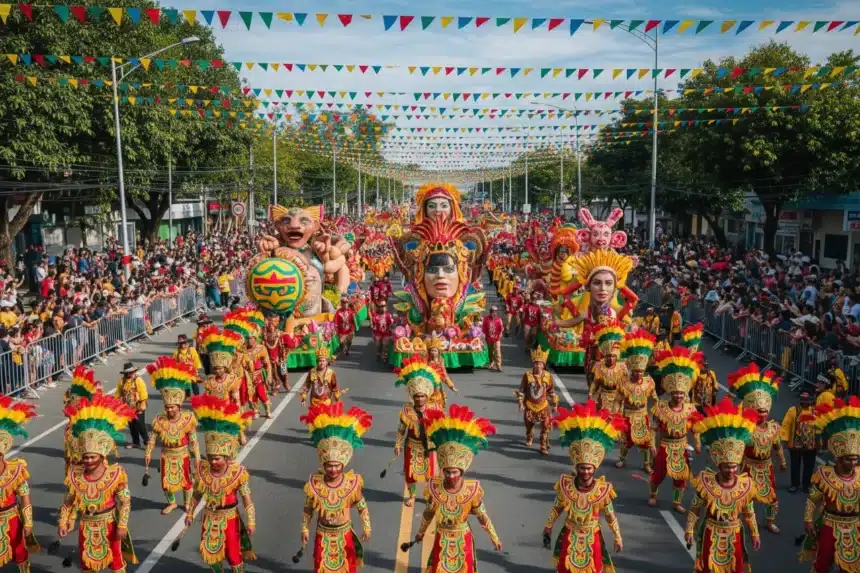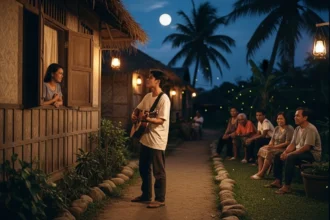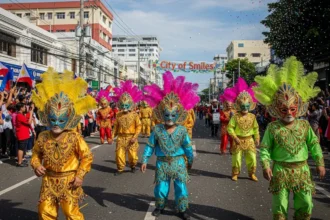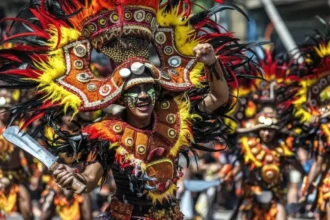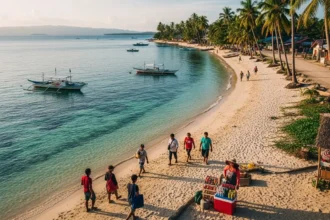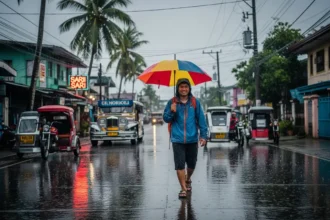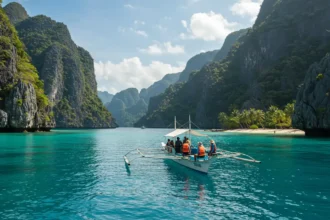Festivals are at the heart of Filipino culture. From north to south, every island in the archipelago celebrates with food, music, costumes, and devotion. In fact, some say you can attend a fiesta in the Philippines almost every day of the year. But among the hundreds of fiestas, a few stand out as the biggest and most colorful festivals in the Philippines – the ones that draw millions of visitors, fill the streets with parades, and showcase the Pinoy spirit in its most joyful form.
- 🎆 Sinulog Festival (Cebu City)
- 🥁 Ati-Atihan Festival (Kalibo, Aklan)
- 💃 Dinagyang Festival (Iloilo City)
- 🌸 Panagbenga Festival (Baguio City)
- 🌞 Pahiyas Festival (Lucban, Quezon)
- 🍇 Kadayawan Festival (Davao City)
- 🎭 MassKara Festival (Bacolod City)
- 🎇 Giant Lantern Festival (San Fernando, Pampanga)
- 🎭 Moriones Festival (Marinduque)
- 🌊 Peñafrancia Festival (Naga City, Camarines Sur)
- 🚤 Zamboanga Hermosa Festival (Zamboanga City)
- 🤹 Higantes Festival (Angono, Rizal)
- 📊 The Biggest and Most Colorful Festivals in the Philippines
- 🎒 Tips for Attending Philippine Festivals
- Frequently Asked Questions about the Biggest and Most Colorful Festivals in the Philippines 2025
- 🌏 Festivals as the Heartbeat of the Filipino Spirit
For Filipinos, festivals are more than parties. They are traditions rooted in faith, history, and harvest. They bring entire communities together – neighbors sharing food, strangers becoming friends, and cities buzzing with life. For travelers, these festivals are windows into the heart of the Philippines: vibrant, diverse, and endlessly hospitable.
Here’s your guide to the must-see, grandest, and most colorful festivals of the Philippines in 2025 – complete with highlights, cultural insights, and reasons why each one deserves a spot on your travel bucket list.
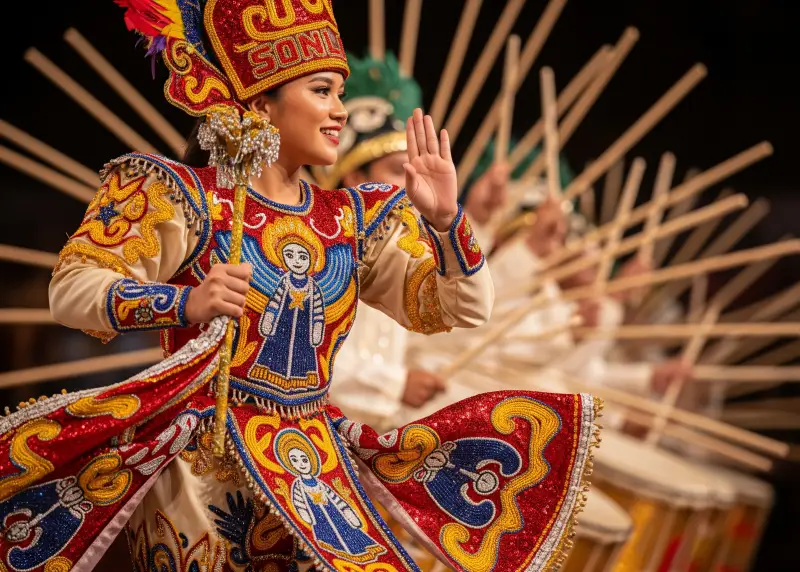
🎆 Sinulog Festival (Cebu City)
Sinulog, celebrated every 3rd Sunday of January, is one of the largest festivals in Asia. It honors the Santo Niño (Child Jesus) through grand processions, novenas, and the famous Sinulog street dancing. Dancers in colorful costumes perform to drumbeats with a signature “two steps forward, one step back” movement that symbolizes prayer.
Beyond religion, Sinulog transforms Cebu into a massive celebration: street parties, concerts, food fairs, and trade expos. Locals and tourists alike chant “Pit Señor!” as they join the revelry. If you want to see the Philippines at its most alive, Sinulog is the ultimate festival.
-
Date in 2025: January 19 (Grand Parade), with events happening throughout the week leading up to it.
-
Where: Parade routes pass through Osmeña Blvd and end at the Cebu City Sports Center. Religious processions also happen around the Basilica Minore del Santo Niño.
-
Highlights: The Grand Parade, Fluvial and Solemn Processions, Festival Queen competition, nightly concerts, and vibrant street parties.
-
How to get there: Fly into Mactan–Cebu International Airport or take ferries from nearby islands. Expect heavy traffic and road closures-walking is often faster.
-
Where to stay: Book early near Fuente Osmeña or downtown Cebu. Hotels fill up months in advance.
-
What to expect: Massive crowds, lively music, and non-stop festivities. Dress light, wear comfy shoes, stay hydrated, and keep valuables secure.
-
Budget tip: Street food and budget hostels are available, but prices for flights and hotels surge around the festival-plan ahead.
-
Insider tip: Arrive early at Osmeña Blvd or near the Sports Center for the best parade views.
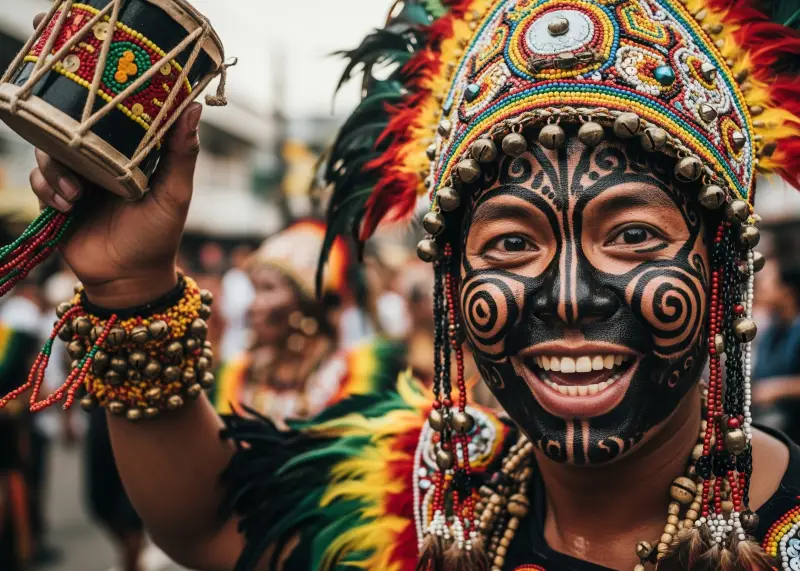
🥁 Ati-Atihan Festival (Kalibo, Aklan)
Happening in January, Ati-Atihan is often called the “Mother of All Philippine Festivals.” Participants paint their faces with black soot and wear indigenous costumes while dancing to nonstop tribal drumbeats. The energy is raw, spontaneous, and infectious – it’s not just performers, but everyone is encouraged to join the dancing.
Ati-Atihan began as a pagan festival honoring the Ati people before being Christianized to celebrate the Santo Niño. Today, it’s both a spiritual and cultural event, blending indigenous tradition with Catholic faith. It’s messy, noisy, and unforgettable – a fiesta that feels truly Pinoy.
-
Date in 2025: January 12–19, with the Grand Parade on January 19.
-
Where: Kalibo, Aklan – the streets around Pastrana Park and the town proper become the main stage.
-
Highlights: Tribes in colorful body paint and costumes, the energetic “Sadsad” street dancing, drumbeats that echo day and night, and the solemn procession of the Santo Niño.
-
How to get there: Fly into Kalibo International Airport or take a bus/ferry from Iloilo, Roxas, or Caticlan.
-
Where to stay: Kalibo has hotels, inns, and homestays, but they fill up quickly – book early. If full, some visitors stay in nearby towns and commute.
-
What to expect: A week-long party that blends prayer and partying. Streets are filled with music, dancing, and food stalls. Crowds are intense but welcoming.
-
Budget tip: Street food and cheap lodging are widely available, but expect festival price hikes.
-
Insider tip: Join the “Sadsad” street dancing – visitors are encouraged to dance with the locals for the full experience.
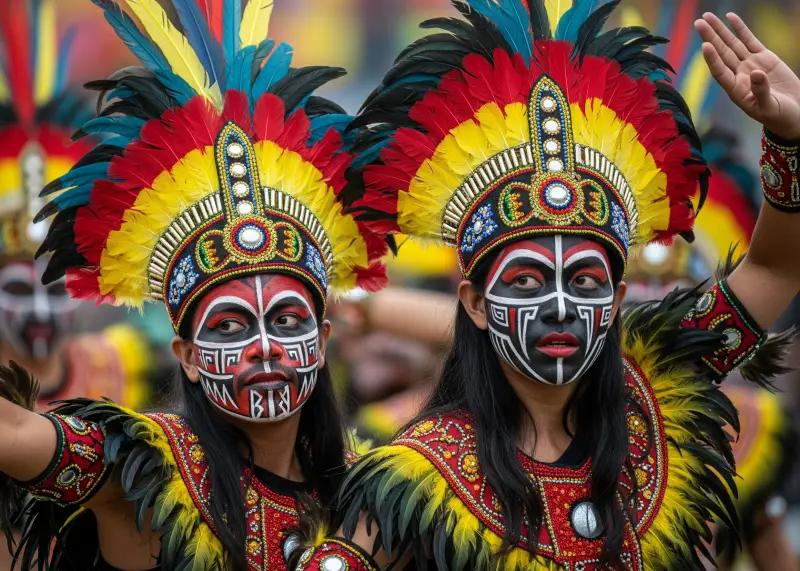
💃 Dinagyang Festival (Iloilo City)
Every 4th Sunday of January, Iloilo hosts Dinagyang, another grand tribute to the Santo Niño. Unlike the freestyle chaos of Ati-Atihan, Dinagyang is known for its highly organized tribal dance competitions. Groups called “tribes” wear elaborate costumes inspired by pre-colonial warriors, with choreography that combines traditional moves and modern spectacle.
The whole city gets involved: schools, businesses, and barangays prepare for months to compete. Dinagyang is also famous for its food fairs, live concerts, and art exhibits. For many, it’s the perfect balance of faith, art, and festival fun.
-
Date in 2025: January 24–26, with the main highlights on January 26.
-
Where: Iloilo City, especially Freedom Grandstand, Iloilo Business Park, and major streets downtown.
-
Highlights: The Ati Tribe Competition (energetic street dances with synchronized choreography), colorful floats, the Fluvial Parade, and cultural shows.
-
How to get there: Fly into Iloilo International Airport or travel by ferry from Bacolod, Cebu, or Manila. Public transport like jeepneys and taxis are available, but roads may be closed during the festivities.
-
Where to stay: Iloilo City offers hotels and homestays; book months ahead since Dinagyang attracts thousands of tourists. Stay near the city center for easy access.
-
What to expect: Loud drumbeats, cheering crowds, and back-to-back performances. It’s more organized than other festivals but equally festive.
-
Budget tip: Food stalls and carinderias keep meals affordable. Accommodations near the parade route are pricier.
-
Insider tip: Secure a viewing pass or get to the routes early for the best spots. Tribes often perform very close to the crowd, giving amazing photo opportunities.
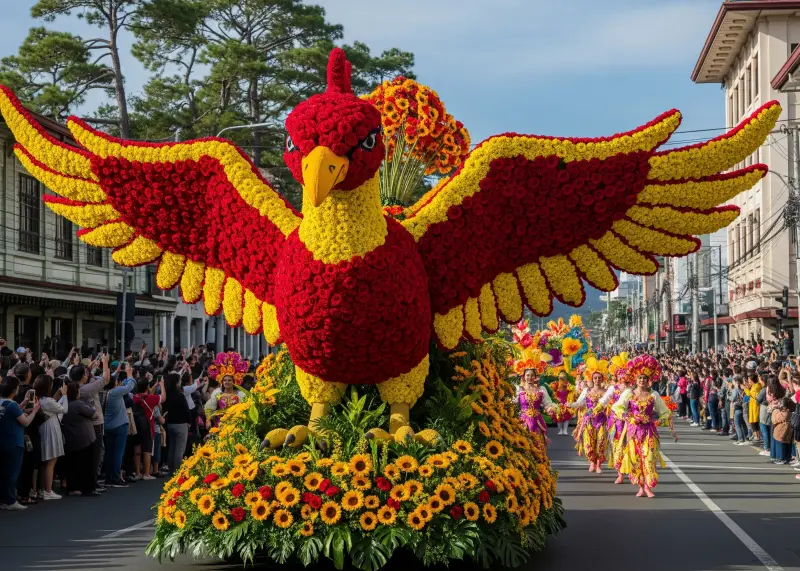
🌸 Panagbenga Festival (Baguio City)
Known as the Flower Festival, Panagbenga brightens Baguio every February. Floats decorated entirely with fresh flowers parade through Session Road, accompanied by street dancers in floral-themed costumes.
Aside from the Grand Float Parade, Panagbenga also features landscaping contests, cultural performances, and the Session in Bloom street fair. Families picnic in Burnham Park while enjoying the cool climate. It’s a feast for the senses, celebrating both Baguio’s culture and its blooming flower industry.
-
Date in 2025: February 1 to March 2, with the Grand Float Parade on March 1 and the Grand Street Dance Parade on February 22.
-
Where: Baguio City, particularly Session Road, Burnham Park, and the Athletic Bowl.
-
Highlights: Floral floats decorated with thousands of fresh flowers, street dancers in flower-inspired costumes, Session Road in Bloom (a week-long street fair with food, crafts, and entertainment), and cultural shows.
-
How to get there: Take a bus from Manila (5–6 hours) or drive via NLEX–TPLEX–Marcos Highway. During the festival, expect traffic and parking difficulties.
-
Where to stay: Hotels, inns, and transient houses in Baguio fill up quickly. Book at least 2–3 months ahead.
-
What to expect: Cool mountain weather, large crowds, and endless photo opportunities. Bring jackets, comfortable shoes, and be prepared to walk.
-
Budget tip: Try street food at Session Road in Bloom for affordable eats. Public transport is limited during parades, so budget extra for taxis or private rides.
-
Insider tip: Arrive early at Burnham Park or Session Road for the best parade views. Local cafés along the route are also great vantage points.
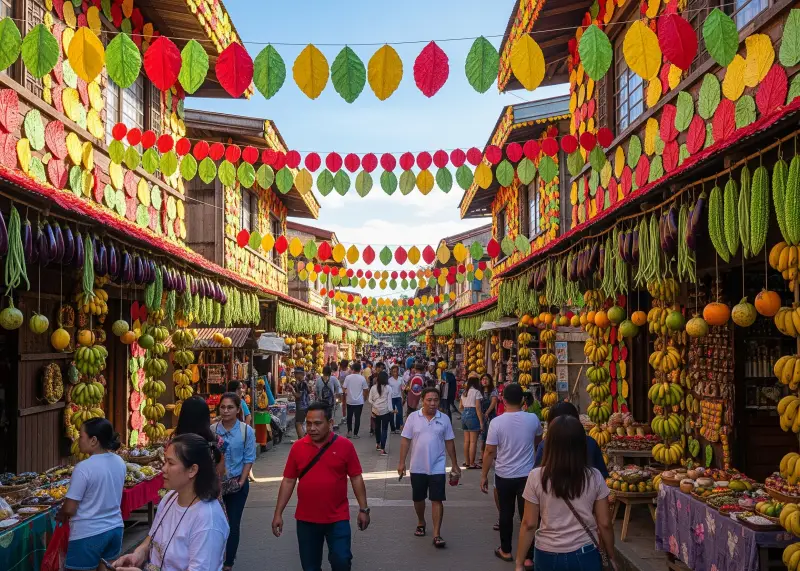
🌞 Pahiyas Festival (Lucban, Quezon)
Every May 15, Lucban transforms into a giant outdoor gallery for the Pahiyas Festival, honoring San Isidro Labrador, the patron saint of farmers. Residents decorate their houses with colorful “kiping” (rice wafers shaped like leaves), fruits, vegetables, and woven crafts.
Walking through Lucban during Pahiyas is like stepping into a rainbow. Each home competes for the most creative display, making every street Instagram-worthy. The festival also showcases Lucban’s culinary pride: pancit habhab, longganisang Lucban, and budin (cassava cake). It’s both a thanksgiving and a cultural showcase of Filipino artistry.
-
Date in 2025: May 15
-
Where: Lucban, Quezon – the whole town becomes the festival stage, with decorated houses lining the streets.
-
Highlights: The parade of carabaos (often painted and dressed up), house-decorating contests, cultural shows, and traditional food like pancit habhab.
-
How to get there: From Manila, take a bus to Lucena, then a jeepney or van to Lucban (around 4–5 hours total). Roads can be crowded on festival day.
-
Where to stay: Limited hotels and homestays in Lucban; many visitors stay in Lucena or nearby towns. Early reservations are a must.
-
What to expect: A cheerful, family-friendly atmosphere with streets bursting with color and creativity. Expect heavy crowds and lots of picture-taking.
-
Budget tip: Try local delicacies like longganisang Lucban and pancit habhab from street vendors for affordable eats.
-
Insider tip: Walk around early in the morning before the biggest crowds arrive to enjoy the decorated houses and take better photos.
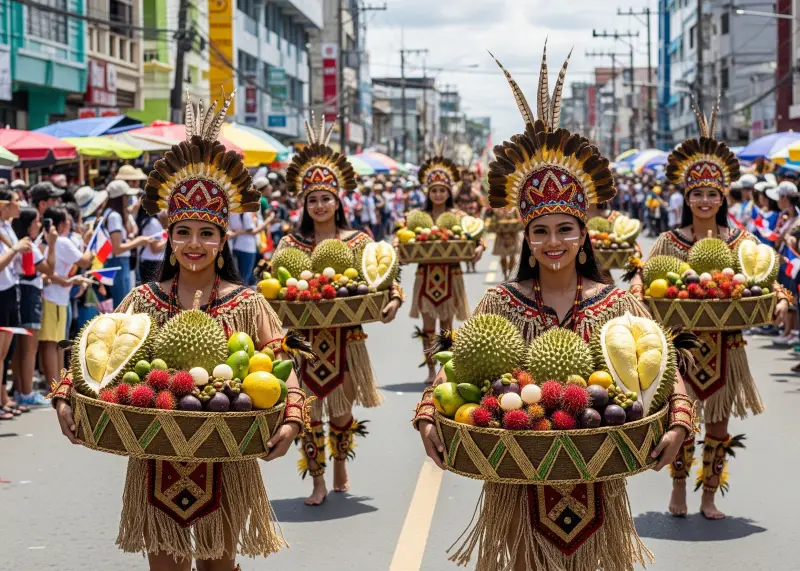
🍇 Kadayawan Festival (Davao City)
Every August, Davao celebrates Kadayawan, a thanksgiving for the city’s bountiful harvest and indigenous heritage. The festival’s highlights include floral floats, tribal dance competitions, and parades featuring durian, pomelo, and other local fruits.
What sets Kadayawan apart is its celebration of diversity – honoring the 11 tribes of Davao through cultural showcases. It’s not just a party, but also an educational experience about Mindanao’s rich traditions. With Davao’s safety and orderliness, Kadayawan is one of the most tourist-friendly festivals in the Philippines.
-
Date in 2025: August 11–17
-
Where: Davao City – key events take place along Roxas Avenue, San Pedro Square, and other central areas.
-
Highlights: The Indak-Indak sa Kadalanan (street dancing competition), Pamulak sa Kadayawan (floral float parade), tribal showcases, and fruit & flower exhibits.
-
How to get there: Fly directly to Davao International Airport from Manila, Cebu, or other major cities. Within Davao, taxis and jeepneys are widely available.
-
Where to stay: Hotels in downtown Davao are most convenient. Since August is peak season, book accommodations well in advance.
-
What to expect: A lively but family-oriented atmosphere, with indigenous dances, music, and cultural exhibits alongside modern festivities. Don’t miss tasting durian and other tropical fruits.
-
Budget tip: Street food stalls and night markets offer cheap meals and local specialties.
-
Insider tip: For the best float parade photos, secure a spot early along Roxas Avenue where floats slow down for performances.
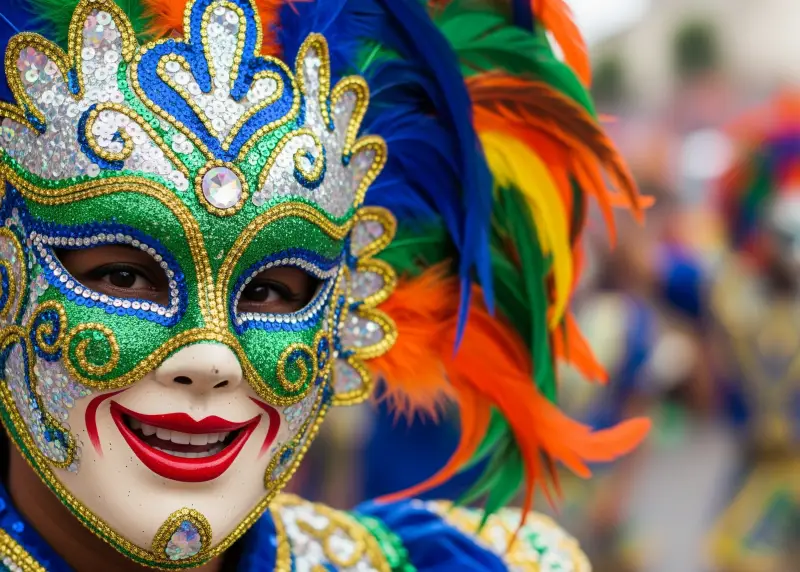
🎭 MassKara Festival (Bacolod City)
Known as the Festival of Smiles, MassKara takes place every October in Bacolod. It began during a crisis in the 1980s, when locals decided to uplift spirits by celebrating life with smiling masks. Today, it has grown into one of the country’s most famous festivals.
MassKara features street dancing competitions with participants in sequined costumes and glittering masks. The city becomes a carnival of lights, music, and food. From mask-making contests to concerts and nightlife events, MassKara showcases the resilience and joy Bacolodnons are known for.
-
Date in 2025: October 17–19 (main highlights)
-
Where: Bacolod City – Lacson Street, Bacolod Public Plaza, and the Bacolod City Government Center are the main venues.
-
Highlights: Mask-making contests, street dancing in colorful costumes, electric MassKara (night parade with lights), concerts, food fairs, and endless street parties.
-
How to get there: Fly into Bacolod-Silay International Airport, then take a shuttle or taxi to the city. Ferries from Iloilo and other Visayas provinces are also available.
-
Where to stay: Hotels near Lacson Street or the city center offer the best access, but rooms sell out fast. Book early.
-
What to expect: A carnival-like atmosphere with smiling faces, upbeat music, and dancing everywhere. It’s festive from day to night.
-
Budget tip: Street food is abundant and affordable; try Bacolod’s famous chicken inasal.
-
Insider tip: Don’t miss the Electric MassKara parade at night – it’s the most dazzling part of the festival.
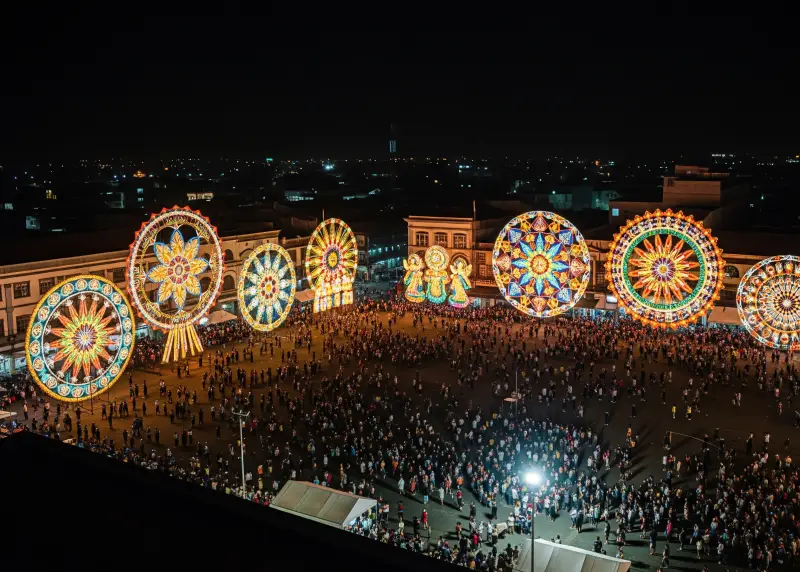
🎇 Giant Lantern Festival (San Fernando, Pampanga)
Every December, Pampanga lives up to its title as the “Christmas Capital of the Philippines” with the Giant Lantern Festival. Here, barangays compete to create enormous lanterns, some reaching up to 20 feet in diameter, lit with intricate designs that dance to music.
The competition attracts thousands of visitors, who marvel at the engineering and artistry behind each lantern. For Kapampangans, it’s a source of pride; for visitors, it’s the perfect way to experience Filipino Christmas spirit at its brightest.
-
Date in 2025: December 20 (Saturday before Christmas)
-
Where: San Fernando, Pampanga – usually at the Robinsons Starmills or major open grounds in the city.
-
Highlights: Gigantic lanterns up to 20 feet wide, each made by different barangays, with dazzling light shows synced to music.
-
How to get there: From Manila, take a bus bound for Pampanga (about 1–2 hours). Private cars via NLEX are also convenient.
-
Where to stay: Hotels in San Fernando and Angeles City are the best options; some visitors do day trips from Manila.
-
What to expect: A festive, family-friendly atmosphere with huge crowds. Arrive early to secure good viewing spots.
-
Budget tip: Street food stalls and Pampanga’s famous local cuisine make eating out both fun and affordable.
-
Insider tip: Stand slightly away from the main crowd to capture the full lantern designs in your photos.
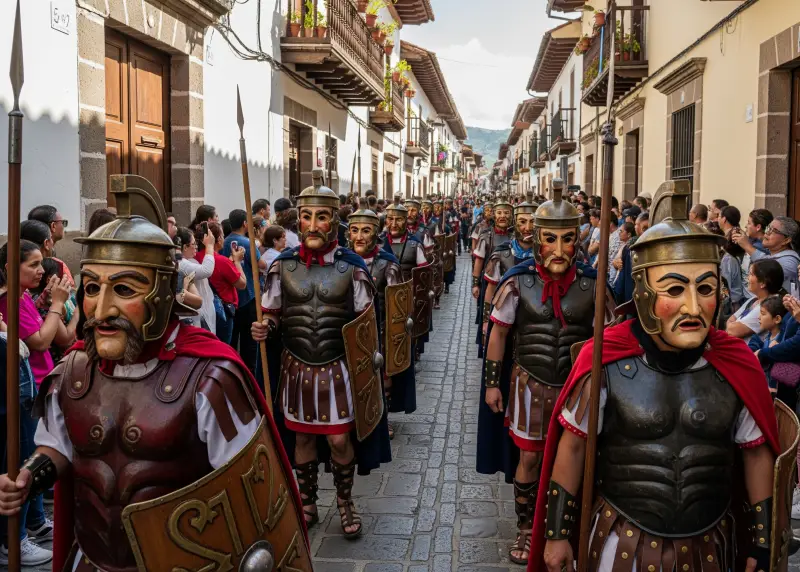
🎭 Moriones Festival (Marinduque)
Celebrated every Holy Week (April 13–19, 2025), the Moriones Festival is one of the most unique religious festivals in the Philippines. Locals wear wooden or papier-mâché masks and Roman soldier costumes, reenacting the story of Longinus – a blind centurion who regained his sight after piercing Christ’s side.
The week-long festival mixes solemn church traditions with lively street performances. For visitors, it’s a striking cultural experience where faith is expressed through theater, art, and costume. Marinduque becomes a living stage, turning Holy Week into a deeply moving and visually colorful event.
-
Date in 2025: April 13–19 (Holy Week, with Good Friday on April 18).
-
Where: Towns across Marinduque, especially Boac, Gasan, and Mogpog.
-
Highlights: Costumed “Morions” roaming the streets, passion plays, religious processions, and the dramatic reenactment of Longinus’ beheading.
-
How to get there: Fly to Marinduque Airport (from Manila) or take a bus to Lucena and ferry to Balanacan Port. Travel gets busy during Holy Week, so book early.
-
Where to stay: Hotels and homestays in Boac and Gasan are the most convenient, but slots are limited – reserve months ahead.
-
What to expect: A mix of solemn religious activities and festive street parades. Crowds are family-oriented, with strong local participation.
-
Budget tip: Homestays are cheaper and give a more authentic experience than hotels.
-
Insider tip: The most photogenic moments are when Morions roam the streets in groups – capture both the costumes and the candid interactions with locals.
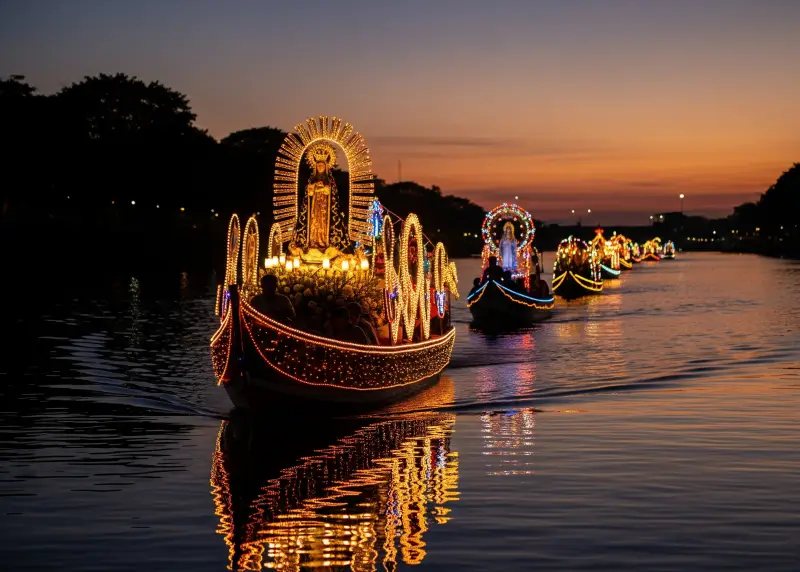
🌊 Peñafrancia Festival (Naga City, Camarines Sur)
Held every 3rd Saturday of September (September 20, 2025), the Peñafrancia Festival honors Our Lady of Peñafrancia, the beloved patroness of Bicol. The highlight is the fluvial procession along the Naga River, where the Marian image is carried on a beautifully decorated pagoda surrounded by candle-lit boats.
For Bicolanos, it’s the pinnacle of devotion, drawing thousands of pilgrims each year. Beyond the religious rites, the festival also features civic parades, concerts, and fairs. It’s one of Asia’s largest Marian festivals and a must-see for its blend of faith, music, and color.
-
Date in 2025: September 12–21, with the Solemn Fluvial Procession on September 20.
-
Where: Naga City, Camarines Sur – key venues include Naga Metropolitan Cathedral, Basilica Minore, and the Naga River.
-
Highlights: The Traslacion (transfer of the image from the Basilica to the Cathedral), nine-day novena masses, civic parades, and the iconic Fluvial Procession where the image is carried on a pagoda boat along the Naga River.
-
How to get there: Fly to Naga Airport (Pili) or take an 8–10 hour bus ride from Manila. Trains from Manila to Naga are also available.
-
Where to stay: Hotels and inns in Naga fill up fast during the festival – reserve months ahead or consider nearby towns.
-
What to expect: A deeply spiritual celebration with massive crowds of devotees. Streets and riversides overflow with pilgrims, food stalls, and cultural events.
-
Budget tip: Stay in nearby towns like Pili or Iriga for cheaper lodging and commute to Naga.
-
Insider tip: The Fluvial Procession is the most moving event – arrive very early to secure a good viewing spot along the Naga River.
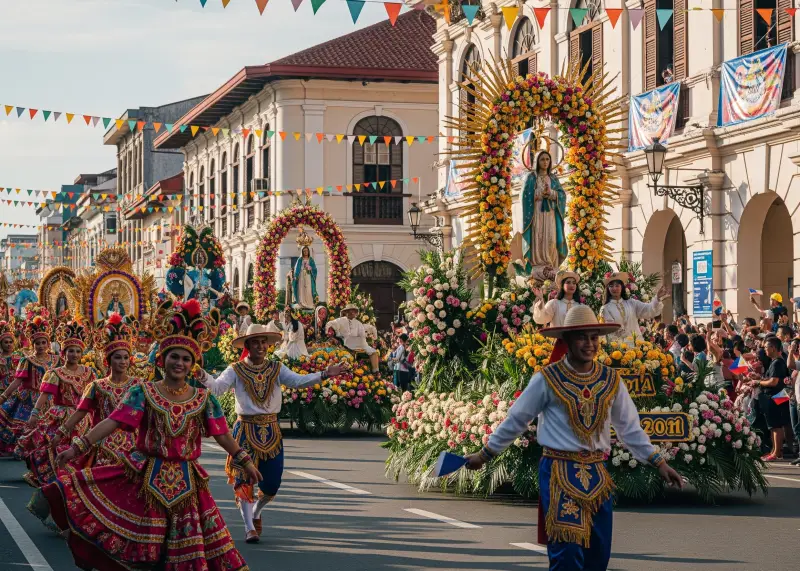
🚤 Zamboanga Hermosa Festival (Zamboanga City)
Every October, Zamboanga City celebrates the month-long Zamboanga Hermosa Festival, also known as Fiesta Pilar, honoring Nuestra Señora La Virgen del Pilar. The biggest highlight is the Regatta de Zamboanga, where dozens of vintas – traditional boats with vibrant sails – race across the waters in a breathtaking spectacle.
The festival also includes religious processions, cultural presentations, trade fairs, and street parades. With its strong Spanish influence and maritime heritage, Zamboanga Hermosa is one of the most unique and colorful festivals in Mindanao.
-
Date in 2025: October 1–12, with the grand highlight on October 12 (Feast Day of Our Lady of the Pillar).
-
Where: Zamboanga City, especially around Fort Pilar Shrine and Paseo del Mar.
-
Highlights: The Regatta de Zamboanga (colorful vintas racing across the sea), Chavacano street parades, cultural fairs, religious novenas, and nightly concerts.
-
How to get there: Fly directly into Zamboanga International Airport from Manila, Cebu, or Davao. Ferries also connect from nearby Mindanao and Visayas ports.
-
Where to stay: Hotels in downtown Zamboanga offer easy access to festival venues; book in advance since October is peak season.
-
What to expect: A mix of solemn devotion and lively festivities. Expect colorful vintas on the water, Chavacano culture on full display, and thousands of devotees flocking to Fort Pilar.
-
Budget tip: Enjoy affordable seafood and local specialties at Paseo del Mar’s food stalls.
-
Insider tip: The Regatta is the most unique event – head to Paseo del Mar early to secure the best viewing spot of the vinta races.
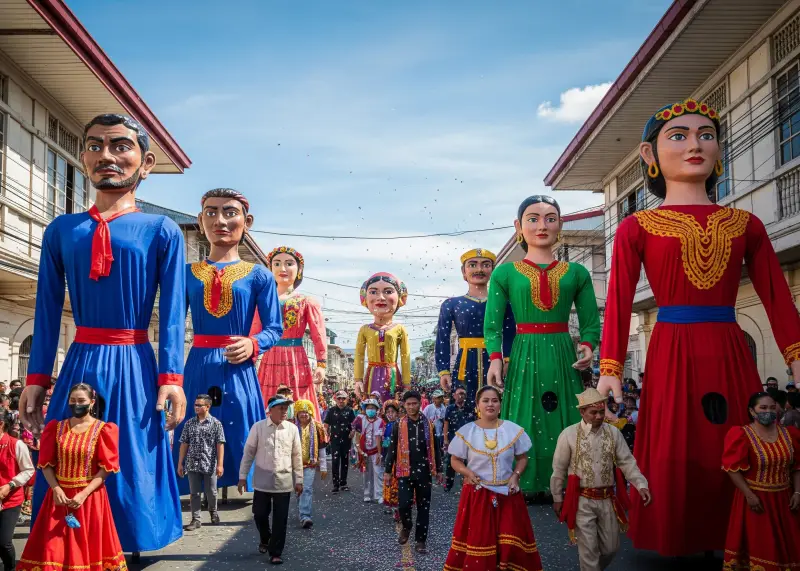
🤹 Higantes Festival (Angono, Rizal)
Celebrated every November 22–23, the Higantes Festival in Angono – known as the “Art Capital of the Philippines” – is a quirky, creative event featuring giant papier-mâché effigies or “higantes” paraded through town.
Originally a form of protest against colonial rulers, the higantes are now symbols of art and community pride. Each towering figure is designed with humor and creativity, often reflecting political satire, folklore, or local culture. Combined with processions honoring San Clemente, the festival showcases both devotion and artistry in true Angono fashion.
-
Date in 2025: November 23
-
Where: Angono, Rizal – parades pass through the town center and end at the church.
-
Highlights: Huge papier-mâché “higantes” (giant figures) up to 12 feet tall, fluvial procession along Laguna de Bay, and cultural performances.
-
How to get there: From Manila, take a bus or UV Express bound for Angono (around 1–2 hours). The town is easily accessible via Ortigas Extension or Marcos Highway.
-
Where to stay: Most visitors do day trips from Manila, but small inns and homestays are available in Angono.
-
What to expect: A lively, family-friendly event with plenty of photo opportunities. Expect packed streets and playful interactions with locals.
-
Budget tip: Day-tripping keeps costs low; food stalls and carinderias line the festival routes.
-
Insider tip: Visit early in the day to watch the preparation of the giants and get less crowded photos before the parades begin.
📊 The Biggest and Most Colorful Festivals in the Philippines
| Festival | Location | Month/Date | Highlight |
|---|---|---|---|
| Sinulog | Cebu City | Jan 19, 2025 | Street dancing, Santo Niño devotion |
| Ati-Atihan | Kalibo, Aklan | Jan 12–19 | Tribal drumming, soot-painted faces |
| Dinagyang | Iloilo City | Jan 26, 2025 | Tribal dance competitions |
| Panagbenga | Baguio City | Feb 23, 2025 | Flower floats, street parades |
| Moriones | Marinduque | Apr 13–19 | Roman soldier masks, passion plays |
| Pahiyas | Lucban, Quezon | May 15, 2025 | Colorful kiping house decorations |
| Kadayawan | Davao City | Aug 17–24 | Harvest celebration, tribal showcases |
| Peñafrancia | Naga City | Sep 20, 2025 | Fluvial procession, Marian devotion |
| MassKara | Bacolod City | Oct 19, 2025 | Smiling masks, street dancing |
| Zamboanga Hermosa | Zamboanga City | Oct 1–31 | Vinta regatta, Marian festivities |
| Higantes | Angono, Rizal | Nov 22–23 | Giant papier-mâché effigies parade |
| Giant Lantern | Pampanga | Dec 20, 2025 | Giant Christmas lantern competition |
🎒 Tips for Attending Philippine Festivals
Attending the biggest and most colorful festivals in the Philippines is an unforgettable experience, but it can also be overwhelming if you’re not prepared. Here are some practical tips to make sure you enjoy every moment:
🏨 Book Early
Hotels and flights get fully booked months before major festivals like Sinulog, Panagbenga, and MassKara. As a rule, book accommodations at least 2–3 months in advance. For smaller towns like Lucban (Pahiyas) or Marinduque (Moriones), staying with relatives or homestays can be a good alternative.
👕 Dress Comfortably
Festivals mean lots of walking, dancing, and standing under the sun. Wear breathable clothes, light shoes or sandals, and don’t forget a hat or umbrella. Some festivals also involve paint, water, or soot (Ati-Atihan), so avoid wearing your best outfit.
📱 Stay Connected
Crowds can be huge, so always have your phone charged (bring a power bank). It helps for navigation, meeting points, and of course – snapping those IG-worthy photos of floats, lanterns, and parades.
🍴 Try Local Food
Each festival is also a food trip opportunity. Don’t miss specialities like Lucban longganisa at Pahiyas, Bacolod inasal at MassKara, or durian during Kadayawan. Street food stalls pop up everywhere, giving you a taste of local flavors.
👜 Keep Valuables Safe
As in any big crowd, be mindful of pickpockets. Carry a small sling bag or waist pouch, and only bring essentials: cash, ID, phone, and a bottle of water.
🙏 Respect Traditions
Many fiestas are rooted in religious devotion. Join the fun, but also respect processions, novenas, and local customs. Filipinos welcome visitors warmly, but courtesy goes a long way.
Frequently Asked Questions about the Biggest and Most Colorful Festivals in the Philippines 2025
-
Which Philippine festival is considered the biggest, and why should I see it?
The Sinulog Festival in Cebu is often called the biggest – it draws millions every January with grand processions, street dancing, and nonstop celebrations. If you want to feel the full force of Filipino festive spirit, that one’s a must-see. -
What makes Filipino festivals so colorful and captivating?
Between the colorful costumes, floats, lanterns, pandesal displays, masks, and indigenous décor, there’s always something vibrant to see. Add music, dance, faith, and street food, and you’ve got an all-senses experience that’s hard to forget. -
Are all these festivals religious in nature?
Not all, though many have religious roots or components-processions, patron saints, etc. Others celebrate harvests, local indigenous culture, or community history. Festivals like Kadayawan or MassKara mix faith with culture, joy, and local identity. -
When is the best time of year to attend festivals in the Philippines?
January is super busy – you’ve got Sinulog, Dinagyang, Ati-Atihan. October is also big with MassKara and Zamboanga Hermosa. December has the Giant Lantern Festival lighting up Pampanga. Think about weather, your travel budget, and what vibe you want (crowded vs more relaxed). -
Do I need to pay to join or watch these festivals?
Most street parades, processions, and public dance activities are free. But parts like concerts, VIP seating, special viewing areas might need tickets. It helps to check in advance for the specific festival you plan to go to. -
What are some tips to make the festival experience smoother and more enjoyable?
Book accommodations early, because hotels fill up fast. Dress comfortably (light clothes, good shoes), bring a hat or umbrella, sunscreen. Stay hydrated. Also, keep your valuables safe in crowds. Oh, and have a backup plan in case roads are blocked or transport is delayed. -
Which festival is best for food lovers?
Pahiyas in Lucban is amazing for trying local Quezon specialties (pang longganisa, budin, etc.). MassKara in Bacolod has good street food, sweets, and seafood. Kadayawan offers huge variety, especially local fruits like durian and pomelo. You’ll get a taste of regional flavors at almost every festival. -
Are these festivals safe for tourists or first-time visitors?
Yes, generally local governments prepare well – crowds, security, traffic control. But it can still get overwhelming. Best to go with a friend or group, keep essentials with you, avoid pushing through crowds, watch out for pickpockets, and follow local guidance. -
Which festivals offer more relaxed vibes if I’m not into big crowds?
Some of the smaller or more cultural festivals can be less intense. For example, visiting during Moriones in Marinduque can be calmer depending on the schedule. Or smaller towns during Pahiyas where you can wander slowly through décor without getting stuck in crowds. -
What’s unique about the Giant Lantern Festival in Pampanga?
It’s a Christmas tradition with massive parols (lanterns) that are sometimes 20 feet wide, intricately designed and lit to music. The craftsmanship is impressive, and the lighting event (usually in December) turns the whole town into a glowing spectacle. Perfect for festive, evening photos.
🌏 Festivals as the Heartbeat of the Filipino Spirit
The biggest and most colorful festivals in the Philippines are more than just parades or events on the calendar – they are living traditions that carry the heartbeat of the nation. Each drumbeat in Ati-Atihan, every flower that blooms in Panagbenga, every lantern that lights up Pampanga is a reflection of the Filipino spirit: resilient, creative, and deeply rooted in faith and community.
For locals, fiestas are times of reunion. Families gather, barangays prepare for months, and neighbors open their homes to strangers who become instant friends. For balikbayans, these festivals are homecomings – a chance to reconnect with the warmth of Filipino hospitality. And for tourists, they are windows into a culture that celebrates life with unmatched vibrance.
But beyond the colors and costumes, these festivals remind us of why Filipinos celebrate. They honor faith, give thanks for blessings, preserve indigenous heritage, and express joy even in times of struggle. That’s why whether you’re shouting Pit Señor in Cebu, tasting pancit habhab in Lucban, or watching vintas race in Zamboanga, you’re not just a spectator – you’re part of a living story that has been passed down for generations.
In 2025, as cities and provinces prepare for another year of fiestas, one thing is certain: the Philippines will once again prove to the world that no one celebrates quite like Pinoys do. Each festival is a reminder that life, no matter how challenging, is always worth celebrating.
So whether you’re planning your next trip, revisiting your hometown’s fiesta, or simply curious about Filipino culture, these festivals invite you to experience the joy, devotion, and unity that define us as a people. After all, in the Philippines, there’s always a reason to celebrate – and there’s always a fiesta waiting for you.



